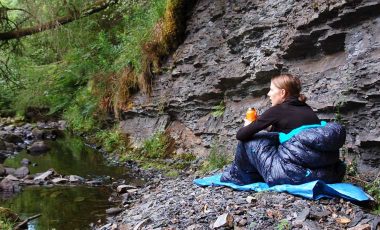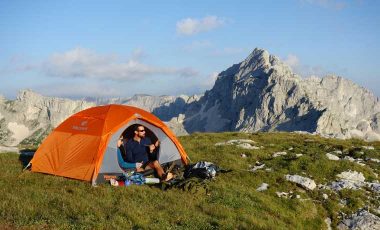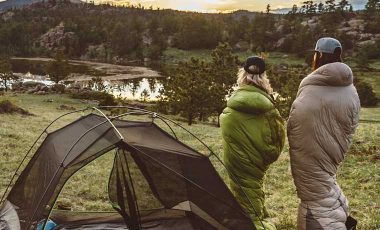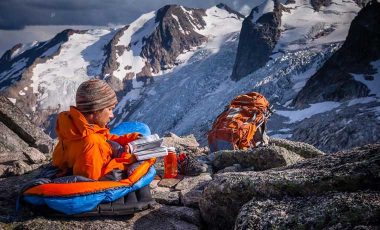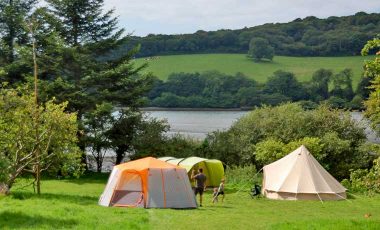Gone are the days of the simple rectangular sleeping bag with one zip down the side, and not much else. Although they are still in existence, those trusty classic bags have also been joined by a whole host of different types of sleeping bags. All sleeping bags are there to provide nighttime warmth and comfort for wilderness sleepers. And it’s important that to choose the right sleeping bag to suit the temperature, the person, the time of year and the location.
So if you are looking for a new sleeping bag but don’t quite know where to begin, we’re here to help. Not only will you come away understanding what shape sleeping bag you need, you will also learn about temperature rating and sleeping bag insulation.
Sleeping bag shape
- Rectangular sleeping bag
- Barrel-shaped sleeping bag
- Mummy sleeping bag
- Double sleeping bag
- Quilt
- Elephant’s foot sleeping bag
Sleeping bag temperature rating
Types of sleeping bag insulation
Disclaimer: We use affiliate links and may receive a small commission on purchases.
Sleeping bag shape
Rectangular sleeping bag
This is the most traditional type of sleeping bag and ideal for those who like lots of room when they sleep. The rectangular shape means that there is plenty of space for tossing and turning providing more comfort to nighttime wrigglers than tapered sleeping bags. The extra space means that rectangular sleeping bags are not renowned for their insulating properties, and they also don’t usually have a hood to keep in the warm air.
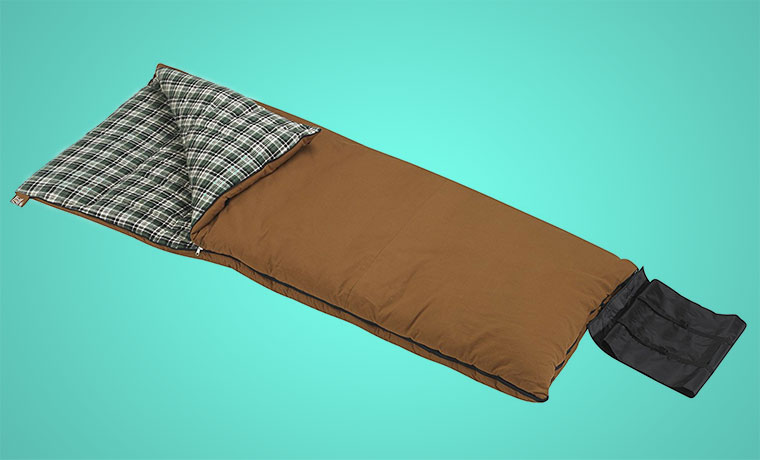
Find the latest price on:
Amazon
Best suited to: Car camping and indoors
Desirable features:
- Lots of foot space
- Zip compatible with other sleeping bags
- Can open out flat to use as a quilt
- Inexpensive
Barrel-shaped sleeping bag
For those looking for the comfort and space of a rectangular sleeping bag without compromising as much on warmth, barrel-shaped sleeping bags are a good option. They have a tapered shoulder area and footbox to decrease some of the dead air in rectangular bags, and sometimes come to with a hood to further maximise on the insulating properties.

Find the latest price on:
Amazon
Best suited to: Car camping and backpacking
Desirable features:
- Hood
- Tapered footbox
- Tapered shoulders
- Colder temperature rating than rectangular bags
Mummy sleeping bag
These are designed to keep sleepers warm in colder conditions. Their shape is contoured to the body with a highly tapered footbox and leg area. There is more width through the hips and shoulders, and further tapering above the shoulders to join a fitted hood that can be tightened with a drawcord.
Mummy sleeping bags excel at keeping you warm and cosy, and are usually much lighter to carry than rectangular and barrel-shaped sleeping bags. Their tapered shape means that there is less room for turning and wriggling and as a result can be less comfortable for some people.

Read more about mummy sleeping bags in our:
Full review of the Big Agnes Sidney SL 25
Best suited to: Backpacking and camping
Desirable features:
- Lightweight
- Good warmth to weight ratio
- Hood with drawcord
- Small pack size
- Draft tube that runs the length of the zip
Double sleeping bag
Double sleeping bags (or two person sleeping bags), are designed to comfortably fit two adults inside. If you love snuggling with your partner at night, or find a single sleeping bag restricting then double bags are ideal. However, what warmth you may gain from the combined body heat of two people in one bag can often be lost due to the loose fit of some double sleeping bags letting in excess cold air. If insulation is key then opt for a sleeping bag with a good hood, like the Big Agnes Dream Island 15.
Some double sleeping bags also unzip completely to make two single sleeping bags, making them much more versatile for the occasions when you’re sleeping alone.
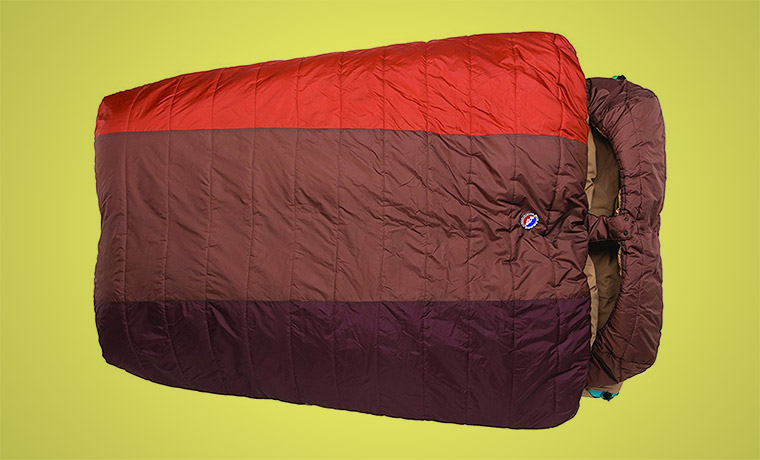
Find the latest price on:
Amazon | REI | Backcountry
Best suited to: Car camping and romantic getaways!
Desirable features:
- Two zippers
- Hood
- Can zip apart into two single sleeping bags
Quilt
There are certain occasions when sleeping in the great outdoors when a sleeping bag is not the best solution to keep you warm at night:
- A full sleeping bag might be too heavy to carry
- You may be sleeping in a hammock where insulation through the underside of the bag is lost due to compression
- It may be too warm to need a full sleeping bag
At these times, opting for a quilt instead of a sleeping bag is a highly appealing option.
Quilts are fast becoming very popular in the backpacking world, and so long you have a good sleeping pad insulating you from below, a good quilt often provides just as much warmth as other types of sleeping bags.

Find the latest price on:
Amazon | Therm-A-Rest | Backcountry
Best suited to: Lightweight backpacking, summer camping and hammock camping
Desirable features:
- Lightweight
- Highly packable
- Good warmth to weight ratio
- Clips to attach around a sleeping pad
Elephant’s foot sleeping bag
As one of the most specific types of sleepings bags around, the elephants foot is designed solely with low weight in mind – ideal for minimalist backpackers and mountaineers. It’s shape is tapered and highly fitted like a mummy sleeping bag, but there is no hood. It is also slightly shorter than other types of sleeping bags and is dependent upon the sleeper wearing an insulated jacket to keep their top half and head warm. Zips are often ¾ length to save weight, or missing altogether, with fasteners that clip together the top half of the bag beneath a sleeping pad (like a quilt).

Find the best prices at:
Brooks Range
Best suited to: Minimalist backpackers and mountaineers
Desirable features:
- Very lightweight
- Good warmth to weight ratio
- Very small when packed down
- ¾ length zip or no zip
- Sometimes has shoulder straps
Sleeping bag temperature rating
Now that you know what types of sleeping bags are available and which one is best suited to your needs, it’s important to understand how sleeping bag temperature rating works. There’s little point in carrying the extra weight of a 3 season sleeping bag if you are backpacking in warm summer conditions. So choose the right sleeping bag for your activity with a temperature rating to match.
Firstly, however, it’s key to understand the different ways in which sleeping bag temperature is rated. There is a huge difference between the comfort rating and the extreme rating. If you only want to survive then use the extreme rating. If actually getting some sleep in relative comfort is more your thing, then always look at the comfort rating.
- Comfort rating – the temperature at which an adult female can expect to sleep comfortably.
- Limit rating – the temperature at which an adult male can expect to sleep comfortably.
- Extreme rating – the lowest temperature at which the sleeping bag will keep an adult female alive. It is a temperature that also poses significant risk of hypothermia and frostbite.
Most sleeping bags are labelled with a ‘limit’ temperature rating making them suitably comfortable for men. But as us ladies generally sleep a little colder than men, we’ll need to look for higher limit rating to stay comfortably warm.
Types of sleeping bags based on temperature
To help you narrow your search for the perfect sleeping bag even further, most types of sleeping bags come under one of these three titles:
| Type of sleeping bag | Low temp limit (ºF) | High temp limit (ºF) | Low temp limit (ºC) | High temp limit (ºC) |
|---|---|---|---|---|
| Summer | 35ºF | Over 35ºF | 1.6ºC | Over 1.6ºC |
| 3 season | 10ºF | 35ºF | -12ºC | 1.6ºC |
| Winter | Under 10ºF | 10ºF | Under -12ºC | -12ºC |
Types of sleeping bag insulation
The final thing to consider when looking at all the different types of sleeping bags is the their insulation. Your main options are simply down and synthetic.
Down sleeping bag insulation
Down insulation is usually the go-to choice for lightweight backpackers and mountaineers due to its excellent warmth to weight ratio. However, the insulating properties of down are severely limited when wet. And once wet, down can take a long time to dry out.
In recent years there have been major advancements in the development of water repellent down by companies such as Down Tek. So if you are after the coveted warmth and low weight offered by down sleeping bags, but frequent wet or snowy environments, Down Tek might just be the solution.
Pros
- Lightweight
- Compressible
- Long lasting
Cons
- Not as warm when wet
- Expensive
 Another consideration when buying down gear is whether the down itself is responsibly sourced, or not. Look out for companies whose down gear is RDS (Responsible Down Standard) certified.
Another consideration when buying down gear is whether the down itself is responsibly sourced, or not. Look out for companies whose down gear is RDS (Responsible Down Standard) certified.
Synthetic sleeping bag insulation
The other main type of insulation for sleeping bags is synthetic. Usually made from polyester, or a variant, synthetic insulation works in much the same way as down but is heavier and less compressible. This makes is less appealing to those trying to keep their gear as small and light as possible, but it manages to maintain its insulation when wet – a major plus for some campers, backpackers and mountaineers.
Pros
- Dries quickly
- Performs well when wet
- More affordable than down
Cons
- Not as compressible as down
- Heavy
For more detail on the benefits of down and synthetic insulation, take a read of our Down Vs Synthetic article which will help you understand which is better for your insulation needs.
With so many different types of sleeping bags available you can enjoy cosy sleeps in warmth and comfort almost anywhere. Whether you are looking for some extra bedding at home, something comfortable for car camping, or something lightweight and mega warm for backcountry adventures, there’s no question that there is a great sleeping bag out there for you.


